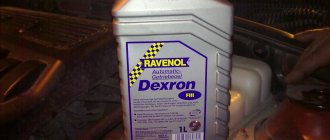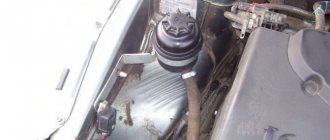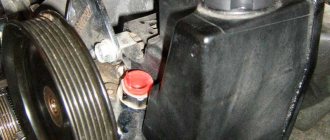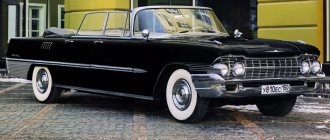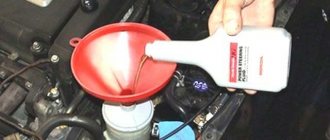The power steering is one of the main components of the steering mechanism. It reduces the force required to apply the steering wheel to make a turn.
This increases the comfort of driving the car, reduces driver fatigue and increases the safety of the car.
For normal operation of the power steering, it is necessary to timely change the oil and use a fluid that meets all the recommendations of the automaker.
Selecting power steering fluid
The official manufacturer recommends using GM Dexron VI oil. General Motors branded fluid has article number 1940184. Its cost starts from 450 rubles. The original oil has a number of advantages:
- low kinematic viscosity,
- possibility of long-term operation without loss of original properties,
- low foaming regardless of temperature,
- small coefficient of thermal expansion,
- good anti-corrosion properties, thereby extending the service life of the main parts of the power steering,
- best lubricating properties.
Original GM Dexron VI power steering oil If the car owner decides to switch to products from a third-party manufacturer, then simple topping up is prohibited. To prevent mixing of different fluids, the system must be flushed and the fluid completely replaced. The cost of non-original oil starts from 400 rubles. Cheaper fluids should not be considered, as they can cause problems in the power steering.
Power steering oil MANNOL DX10105
What to pour into the power steering
The answer to this question is simple - the fluid that your car manufacturer recommends. And it is unacceptable to conduct experiments here. The fact is that if you constantly use oil that is not suitable in composition for your power steering, then over time there is a high probability of complete failure of the hydraulic booster.
Therefore, when choosing which fluid to pour into the power steering, the following factors must be taken into account:
GM ATF Dexron III
- Automaker recommendations. There is no need to engage in amateur activities and pour anything into the power steering system.
- Mixing is permissible only with similar compositions. However, it is not advisable to use such mixtures for a long time. As soon as possible, replace the fluid with the one recommended by the manufacturer.
- The oil must withstand significant temperatures. Indeed, in the summer they can warm up to +100°C and above.
- The liquid must be sufficiently fluid. Otherwise, there will be an excessive load on the pump, which will lead to its premature failure.
- The oil must have a significant service life. Typically, replacement is carried out after 70...80 thousand kilometers or once every 2-3 years, whichever comes first.
Also, many car owners are interested in questions about whether it is possible to pour transmission oil into the gearbox? Or motor oil? As for the second, it’s worth saying right away - no. But as for the first ones, they can be used, but with certain reservations.
The two most common types of fluids are Dexron and Power Steering Fuel (PSF). Moreover, the first one is more common. Currently, fluids that meet the Dexron II and Dexron III standards are mainly used. Both compounds were originally developed by General Motors. Dexron II and Dexron III are currently produced under license by numerous manufacturers. They differ from each other in the temperature range of use. The German concern Daimler, which includes the world famous Mercedes-Benz, has developed its own power steering fluid, which is yellow in color. However, there are many companies in the world that produce such compounds under license.
Compliance of machines and power steering fluids
Here is a small table of correspondence between power steering fluids and specific car brands.
| car model | Power steering fluid |
| FORD FOCUS 2 (“Ford Focus 2”) | Green - WSS-M2C204-A2, Red - WSA-M2C195-A |
| RENAULT LOGAN (“Renault Logan”) | Elf Renaultmatic D3 or Elf Matic G3 |
| Chevrolet CRUZE (“Chevrolet Cruze”) | Green – Pentosin CHF202, CHF11S and CHF7.1, Red – Dexron 6 GM |
| MAZDA 3 (“Mazda 3”) | Original ATF M-III or D-II |
| VAZ PRIORA | Recommended type - Pentosin Hydraulik Fluid CHF 11S-TL (VW52137) |
| OPEL (“Opel”) | Dexron different types |
| TOYOTA (“Toyota”) | Dexron different types |
| KIA (“Kia”) | DEXRON II or DEXRON III |
| HYUNDAI (“Hyundai”) | RAVENOL PSF |
| AUDI (“Audi”) | VAG G 004000 M2 |
| HONDA (“Honda”) | Original PSF, PSF II |
| Saab (“Saab”) | Pentosin CHF 11S |
| Mercedes (“Mercedes”) | Special yellow compounds for Daimler |
| BMW (“BMW”) | Pentosin chf 11s (original), Febi S6161 (analogue) |
| Volkswagen (“Volkswagen”) | VAG G 004000 M2 |
| Geely (“Geely”) | DEXRON II or DEXRON III |
If you did not find the brand of your car in the table, we recommend that you look at the article about the 15 best power steering fluids. You will probably find a lot of interesting things for yourself and select the fluid that is optimal for the power steering of your car.
Blog Search
Check the level of consumables in the expansion tank again and, if necessary, add the substance. Return pipe under the tank 2. Collection of waste substances Cost of issue The cost of consumables will depend on the manufacturer, as well as the quality of the substance. A product that meets the same characteristics, only from the manufacturer Febi, costs around rubles per liter, and from the manufacturer Castrol - about rubles per liter.
Poll Have you ever encountered the need to change the power steering oil?
How to change power steering fluid
If the power steering fails, it is possible to drive the car, but the steering wheel will be difficult to turn and will become heavy. During operation, Chevrolet Cruze power steering fluid can leak in various places, most often through hoses.
As a result, the power steering oil level will drop. Driving without fluid in the Chevrolet Cruze's power steering puts you at risk of breaking the power steering pump, which costs a lot of money, as it will run dry. As a result, it will suffer serious damage and fail. If your Chevrolet Cruze is left without oil in the power steering system, then the best solution is to call a tow truck.
Intensive use of the Chevrolet Cruze makes the color of the power steering oil darker over time, often with a burning smell. Low-quality liquid will not improve the performance of the device and may damage it. Using a jack, raise the front of the car until both wheels stop touching the surface. To secure it in this position, stops should be placed under the side members.
Remove the plug from the tank. There are two types: Depending on the make of the car, you will either need to remove the power steering reservoir or the fitting.
vote
Article rating
Chevrolet Cruze 2012, 141 l. With. — scheduled maintenance
Rubber cracks and dries out at high temperatures; to prevent this from happening, mineral oils are used. They are used, but less often than mineral water. The thing is that there may be rubber fibers present here, which have a detrimental effect on the oil seals and rack seals. However, now more and more rubber products have begun to be made with the addition of silicone, so the use of synthetics is growing.
Still, you should look at the operating manual for your car or consult with an official dealer. Only then can synthetic liquids be poured, that is, strict recommendations or approvals are needed. How and with what can you mix it?
The question is complex, however, there are few hints from manufacturers regarding power steering oils. Now there are only three main colors of liquids, red, green and yellow.
Replacing power steering fluid
In order to replace power steering fluid in a Chevrolet Cruze with 1.6 (109 hp) and 1.8 (141 hp) liter engines, you must follow the instructions below.
Brake the car using the handbrake. Place wheel chocks under the rear wheels. Using jacks, raise the front of the car. If there is a lift, it is necessary to hang the car so that nothing interferes with the rotation of the front wheels.
The front part of a Chevrolet Cruze raised with a jack
Using a syringe, pump out the fluid from the power steering reservoir.
The process of pumping fluid out of the power steering reservoir
- Unscrew the power steering reservoir.
- Remove the thin return hose from the power steering reservoir.
- Insert the dismantled hose into an empty container, for example, a plastic bottle.
Container for draining old fluid
Remove the tank. If there is a deposit of old slurry inside it, then you need to clean the walls.
Dismantled tank
- Place the tank in place. Pour in about half a liter of fresh liquid.
- Without starting the engine, you need to start turning the steering wheel from the extreme left position to the extreme right position. At the same time, liquid will begin to flow from the hose inserted into the bottle. It is not known exactly how much oil will spill out, but on average you should expect to drain up to a liter of used fluid.
- It is necessary to turn the steering wheel until fresh liquid flows into the substituted container. In this case, it is necessary to constantly monitor the oil level in the tank. When the level decreases, it is necessary to constantly bring it to about.
Power steering fluid replacement process
To clean the power steering pump, you need to start the engine for 1-2 seconds
In this case, it is important to carefully monitor the fluid level in the tank. If the oil level drops too low, there is a risk of airing the circuit.
For this reason, many car owners change the power steering oil without starting the engine. Connect all hoses to the tank. Pour liquid up to about. Start the engine and check the operation of the power steering.
Replacing power steering fluid
Gradually I began to change all the fluids in the car, I did not change it because the power steering was humming (I always change it in advance, and according to the replacement regulations it was time to do it). I’ll say right away that it hasn’t gotten any better... or worse) I’m just calm now and will know that I have a high-quality fluid that has been tested by many!) This replacement method is not partial, all the old fluid comes out of the system! We will need power steering fluid 1 liter
(I chose
Motul ATF 6
...order number 103217),
pliers
,
a 10mm wrench
,
an empty bottle
and
a syringe device with a suitable hose
(you can use a dropper).
First of all, we raise the front part of the car using two jacks (you don’t have to do this, but it will be difficult to turn the steering wheel with the car turned off)
Use a syringe to pump the fluid out of the power steering reservoir into a bottle.
We unscrew the power steering reservoir (one bolt), there are two hoses: a thin one (return) that goes to the steering wheel and a thick one that goes to the power steering pump. We need a thin one, we disconnect it from the tank and carefully insert it into the bottle
Disconnect the thick hose (nothing will escape from it) and remove the power steering reservoir to wash it (you can use gasoline)
Source
Functions of power steering fluids
The functions of power steering oils include:
- transfer of pressures and forces between the working bodies of the system;
- lubrication of power steering components and mechanisms;
- anti-corrosion function;
- transfer of thermal energy to cool the system.
Hydraulic oils for power steering contain the following additives:
PSF fluid for power steering
- reducing friction;
- viscosity stabilizers;
- anti-corrosion substances;
- acidity stabilizers;
- coloring compounds;
- antifoam additives;
- compositions for protecting rubber parts of the power steering mechanism.
ATF oils perform the same functions, but their differences are as follows:
- they contain additives that increase the static friction of clutches, as well as reduce their wear;
- The different fluid compositions are due to the fact that clutches are made of different materials.
Any power steering fluid is created on the basis of a base oil and a certain amount of additives. Due to their differences, the question often arises as to whether different types of oils can be mixed.
Changing Power Steering Oil
to change oil without problems
in GUR
. All videos on the page.
Place the steering wheel in a straight-ahead position with the vehicle.
Install armrests under the rear wheels, hang the front of the car. Remove the front wheels.
Disconnect the outer ends of the tie rods from the knuckle arms.
In the cab, under the pedal assembly, unscrew the clamping bolt of the lower hinge joint with the steering rack mechanism shaft.
Remove the engine splash guards. Remove the intake pipe
Unscrew the bolt securing the pipe clamp, disconnect the pipes from the mechanism and drain the working fluid from the power steering system into a previously prepared container or plugs.
While holding onto the rotation of the stabilizer link upper mount pin, unscrew the nut and pull the stabilizer link upper mount pin out of the front suspension strut bracket.
Oil Change Guide
So, changing the power steering oil is an integral part of the maintenance of a Chevrolet Cruze car. The fluid replacement procedure can be performed at home.
What the replacement process looks like:
- First, you will need to jack up the front of the car, this is necessary so that the front wheels can rotate freely. If you don’t have jacks, then as an option, you can use a slippery surface, for example, ice, wet grass, etc.
- Next, open the hood and unscrew the filler plug of the power steering reservoir. Using a large medical syringe with a nozzle installed on it, it is necessary to pump out all the consumables from the tank.
- After that, look under the tank - there should be two pipes along them. The pipe that connects to the power steering pump must be disconnected, but before doing this, place a container under it, for example, a cut-off bottle. You need to wait until all the oil has left the system.
- Next, disconnect the second pipe - this is the so-called return pipe. The return line is marked in more detail in the photo. You also need to place a container under this hose, since oil will also come out of it.
In order to pump out spent consumables from the power steering system as much as possible, the car’s wheels must be turned first completely to the right, and then completely to the left.
In this case, in extreme positions it is necessary to pause for several minutes. This procedure is repeated until oil stops coming out of the return line.
If the volume of a substance decreases as a result of manipulation, it will need to be replenished. The procedure is repeated until the level of the substance in the expansion tank stops decreasing.
After completing these steps, you can start the power unit. Immediately after starting, you can hear the power steering pump humming. Some car enthusiasts immediately check the pump, the pump itself and other elements of the system, but this is unnecessary, since the appearance of sound initially after replacement is normal. When the substance disperses throughout the system, all noise should disappear.
When the engine is running, the procedure of turning the steering wheel to the extreme right and left is repeated, only there is no need to pause. Check the level of consumables in the expansion tank again and, if necessary, add the substance.
Price issue
The cost of consumables will depend on the manufacturer, as well as the quality of the substance. For example, the cost of one liter of MOTUL Dexron IID today is about 600 rubles. A product that meets the same characteristics, only from the manufacturer Febi, costs around 420 rubles per liter, and from the manufacturer Castrol - approximately 520 rubles per liter.
Watch an interesting video on this topic
During the operation of the vehicle, the oil poured into the power steering circuit ages. As a result, the components of the hydraulic booster begin to wear out excessively. To prevent this, it is recommended to periodically replace the power steering fluid.
Otherwise, the need for a major overhaul of the steering will not be long in coming.
Power steering oil for Chevrolet Cruze
What kind of fluid to pour into a Chevrolet Cruze
The power steering is the main unit in the control system of any car. In order for the power steering to always work properly, it is necessary to check the condition of its parts and devices, as well as promptly change the working fluid in the system. Find out how to change GUR Lacetti water and when to change the oil. see this material.
For Chevrolet Lacetti, Chevrolet Cruz and many other models of this manufacturer, the power steering is the main consumable item, the condition of which determines the operation of the unit as a whole.
Unfortunately, the technical regulations do not indicate a clear oil change time, but many car owners say that after 15 thousand kilometers the fluid should be changed in any case (video creator Nikita Kislyakov).
What signs may indicate the need for an oil change:
- the liquid has changed its color, become blacker, and may have sediment;
- absorbing pungent odors;
- the steering wheel has become more difficult to turn;
- When turning the steering wheel, sounds unusual for its operation are heard.
Dextron 2 or Dextron 3 is initially poured into the steering wheel during the manufacture of power steering. It is better to fill out what the car manufacturer recommends.
Therefore, replacing the power steering is an integral part of the maintenance of the Chevrolet Lacetti. The water changing function can be performed at home.
Replacing the steering wheel on a Chevrolet Cruze
What does the change process look like?
- First you need to connect the front of the car, this is necessary so that the front wheels can rotate freely. If you don't have jacks, you can use slippery surfaces like ice, wet grass, and more.
- Next, open the hood and remove the power steering reservoir cap. Using a large honey syringe with a nozzle installed on it, you need to pump out all the consumables from the tank.
- Then look under the tank. there should be two pipes there. The pipe that connects to the power steering pump needs to be disconnected, but before doing so, you should replace the container, such as a cut bottle. You need to wait until all the oil has left the system.
- Then disconnect the 2nd pipe. This is the so-called return. More precisely, the return is marked in the photograph. This hose also needs to be replaced because oil will also come out.
To pump out consumables from the power steering system, you first need to turn the car's wheels one hundred percent to the right, and then one hundred percent to the left. With all this, in the last positions you need to pause for a couple of minutes. This procedure is repeated until oil flows out of the return line.
- When the substance disappears, wipe the end of the first nozzle removed and try to blow it out. If supplies remain in the system, they must exit the system.
- Next, the pipe itself must be connected back to the expansion tank. Once you have completed these steps, you can fill the tank with new materials. In this case, the volume of the spilled substance must correspond to the volume of drained oil, no more and no less. When filling, focus on the marks on the tank. the volume of the substance must be between MIN and MAX.
- When the substance is filled, the power steering system is pumped. This step is very important and cannot be skipped. Proceed strictly according to the instructions, as these steps determine the effectiveness of the work you do.
- Therefore, with the engine off (do not try to start it), you must slowly turn the control wheel to the right and left to the last position. In this case, the steering wheel should linger for a few seconds in each last position, as you did before. Turn the steering wheel to make sure that the level of consumables in the expansion tank is not reduced to a minimum. It is also better not to let air into the system, otherwise this will be a necessary condition for the formation of air locks. And in turn, this will cause noise and noise when steering, so be careful.
If as a result of manipulation the volume of a substance decreases, it will need to be replenished. The procedure is repeated until the level of the substance in the expansion tank is reduced. You can start your device by following these steps. Immediately after starting, you will hear the hum of the booster pump. Some car owners immediately inspect the pump, the pump itself and other elements of the system, but this is not necessary since the sound first appears after a normal change. When the substance is sprayed onto the system, all noise should disappear.With the engine running, the process of turning the steering wheel to the last right and left positions is repeated, but you don't have to stop at it all. Check the level of consumables in the expansion tank and add if necessary.
A simple way to get rid of power steering noise
The cost of consumables will depend on the manufacturer and the properties of the substance. For example, the price of a 1-liter MOTUL Dexron IID is now about 600 rubles. A product that meets the same characteristics, only from the manufacturer Febi, costs about 420 rubles per liter, and from the manufacturer Castrol. about 520 rubles per liter.
The video below provides a nicer note about replacing consumables in a garage environment (video creator: konran00 channel).
Selecting power steering fluid
- low kinematic viscosity;
- possibility of long-term operation without loss of original properties;
- low foaming regardless of temperature;
- low coefficient of thermal expansion;
- good anti-corrosion properties, thereby extending the service life of the main parts of the power steering;
- best lubricating properties.
Original power steering oil GM Dexron VI
If the car owner decides to switch to products from a third-party manufacturer, then simple topping up is prohibited. To prevent mixing of different fluids, the system must be flushed and the fluid completely replaced. The cost of non-original oil starts from 400 rubles. Cheaper fluids should not be considered, as they can cause problems in the power steering.
Power steering oil MANNOL DX10105
How to determine the need to change the power steering oil?
On the Chevrolet Lacetti, Chevrolet Cruze and many other models of this manufacturer, power steering fluid is an important consumable, the condition of which determines the operation of the unit as a whole. Unfortunately, the technical regulations do not indicate the exact timing of oil changes, but many car enthusiasts claim that after 15 thousand kilometers the fluid should be changed in any case (video author - Nikita Kislyakov).
What signs may indicate the need for an oil change:
- the liquid has changed its color, become darker, and may contain sediment;
- consumables smell like burning;
- the steering wheel has become more difficult to turn;
- When turning the steering wheel, sounds uncharacteristic of its operation may be heard.
Selecting and changing oil for power steering Chevrolet Cruze
Power steering fluid is oil, the use of which is necessary for the proper functioning of all steering components. Older car models do not have such a system element as power steering (hydraulic booster).
But innovations in mechanical engineering dictate their own rules, and now, for safe movement in your car, you need to monitor what kind of oil is poured into the power steering of the Chevrolet Cruze and whether it is in the right quantity.
The rules for caring for the hydraulic booster are quite simple: monitor the fluid level and add or change it in time. The quality of the product plays a big role, since incorrectly selected oil evaporates prematurely and disrupts the proper operation of the steering wheel, as well as other components and elements of the system.
What kind of oil to fill in the Chevrolet Cruze power steering
Dexron VI only.
For those who are too lazy to read further, let’s say right away that only transmission oils designated on the label as Dexron VI are poured into the Chevrolet Cruze hydraulic booster, regardless of engine type. In this case, the company that produced the liquid is practically irrelevant.
A branded liter package of GM Dexron VI can contain liquid from a variety of manufacturers, so if there is a standard name on the label, you can even save a little.
Why Dexron VI?
Since 2006 only Dexron VI!
General Motors has completely switched to Dexron VI fluids since 2006, replacing Dexron III oils, and there are several reasons for this.
Many manufacturing companies still sell the third Dexron, and Dexron IID, IIE, but they cannot be used in power steering Chevrolet Cruze, since the General Motors concern no longer guarantees the quality of old fluids, especially from third-party manufacturers.
Features of power steering fluid
In the process of completely changing the oil in the power steering.
The new, sixth Dexron has a number of features, without which the Cruise power steering will quickly wear out or not work correctly:
- Low kinematic viscosity within 6.5 centistokes, whereas for liquids of previous years of production this figure is more than 7.5-8 at a temperature of one hundred degrees.
- Extended service life, extended to 8-9 years.
- Low foaming.
- Low coefficient of thermal expansion.
- High anti-corrosion properties.
- Improved lubrication characteristics.
When to change the oil
The frequency of oil changes in the power steering of a Chevrolet Cruze depends on many factors, including driving style and operating conditions. Sudden maneuvers and turns of the steering wheel can negatively affect the shelf life of the oil, which will have to be changed ahead of schedule.
In this case, the replacement schedule may be less than 50 thousand km, especially if there are characteristic signs of bad oil: low level, blackening due to wear products, clogged filter elements, tight force on the steering wheel and poor feedback. In addition, if the oil is spoiled, leaks may occur in the places where the power steering pipelines are attached, which clearly indicates a violation of their tightness.
Selecting power steering fluid
The official manufacturer recommends using GM Dexron VI oil. General Motors branded fluid has article number 1940184. Its cost starts from 450 rubles. The original oil has a number of advantages:
- low kinematic viscosity;
- possibility of long-term operation without loss of original properties;
- low foaming regardless of temperature;
- low coefficient of thermal expansion;
- good anti-corrosion properties, thereby extending the service life of the main parts of the power steering;
- best lubricating properties.
Original power steering oil GM Dexron VI
If the car owner decides to switch to products from a third-party manufacturer, then simple topping up is prohibited. To prevent mixing of different fluids, the system must be flushed and the fluid completely replaced. The cost of non-original oil starts from 400 rubles. Cheaper fluids should not be considered, as they can cause problems in the power steering.
Power steering oil MANNOL DX10105
Search
The power steering on the Chevrolet Lacetti is quite reliable, not demanding and attracts attention relatively periodically. Well, it doesn't need much attention - just look at the water level in the tank and see how the device works while driving
But from time to time you need to know what kind of oil to pour into the Lacetti power steering, whether you can combine fluids of different brands and classes. In principle, everything is very simple - General Motors Korea always keeps up with the times and updates its water class.
For example, by 2009, 1100 ml was poured into the power steering. GM Dexron II, following the introduction of the Dexron III, IV and Dexron IIE standard. But these are just names.
Here is the water specification for the various compliance standards:
As follows, the native fluid can be replaced with any appropriate standard, and GM specifically recommends Dexron.
We will not argue with them, say, pour premium oil, for example. Dexron VI, this makes no sense since it was created in 2005 specifically for the HydraMatic 6L80 automatic transmission.
The main difference between Dexron 6 and Dexron 3 is the change in kinematic viscosity. The least viscous Dexron 6 oil allows you to reduce the coefficient of friction in an automatic transmission, but in a hydraulic booster this indicator is not the most important. At least if the package says DEXRON power steering, it can be safely used to refill the power steering system on the Lacetti. An analogue of this oil is Mobil ATF320, or at least some oil that has the UGMS approval mark.
We will not theorize, but we will immediately put ourselves in the shoes of the Lacetti driver, who saw that the water level in the tank was lower than necessary. If there are no leaks or obvious problems with the amplifier, and the fluid is still more or less fresh, in other words, it makes sense to add it. At the top there is usually a brand Jiemovsky DEXRON power steering III. If we are sure that it is specially poured into the system. However, the composition of this oil differs from the industrial spindle, which at each machine-building plant was filled only with a set of additives, and the cost is not dictated by the proletarian origin of the oil.
The color of the water is reddish at first, but it can change greatly over time. This will tell you it's time to change the oil. However, the manufacturer says that the oil is filled for the entire life of the car, although experienced Lackett owners change the fluid every 50-60 thousand km.
Replacing power steering fluid. Gentra / Lacetti
Water discoloration of the steering wheel indicates that it is time to replace it.
The same DEXRON power steering. Regardless of the index, almost all Chevrolet, cheap Toyota and Opel are in power steering. If we decide to completely change the fluid, we will definitely wash the system before filling - You can mix water with various additives that can cause foaming or precipitation. This will certainly affect the stability of the power steering.
Partial oil change
Some car owners resort to a simpler method of changing power steering fluid. This requires:
- Open the power steering reservoir cap.
- Use a syringe with an extension hose to completely pump out the liquid.
Liquid pumping process
- Fill with fresh fluid to the “Max” level.
- Start the engine and turn the steering wheel.
- Visually assess the condition of the oil. If necessary, pump out and refill with fresh fluid. Some car owners recommend using oil passed through a filter at the intermediate stage.
- When the liquid in the tank is the same color as fresh, close the lid.
- Check the functionality of the power steering.
What kind of fluid is poured into the power steering in a Chevrolet Lacetti
The power steering on the Chevrolet Lacetti is quite reliable, not capricious and relatively rarely attracts attention. And it doesn’t need special attention - just check the fluid level in the tank and monitor the operation of the device while driving
However, sometimes you need to know what kind of oil to pour into the Lacetti power steering, whether it is possible to mix different brands and classes of fluids.
What kind of oil is poured into the power steering on a Chevrolet Lacetti from the factory?
For example, until 2009, 1100 ml of GM Dexron II was poured into the power steering on a conveyor, after which the standard Dexron III, IV and Dexron IIE appeared. But these are just names.
Here is the fluid specification according to different compliance standards:
- SAE 75W-80;
- API GL-3/GL-4;
- Ford Mercon;
- C4 Allicon.
Dexron VI
We will not argue with them, we will only say that it makes no sense to fill in a higher class oil, for example, Dexron VI, since it was developed in 2005 specifically for the HydraMatic 6L80 automatic transmission.
GM Dexron VI oil.
The main difference between Dexron 6 and Dexron 3 is the change in kinematic viscosity. Less viscous Dexron 6 oil allows you to reduce the coefficient of friction in an automatic transmission, but in a hydraulic booster this indicator is not the most important.
An analogue of this oil is Mobil ATF320 or any oil that has GM approval on the label.
Mix, add and change power steering oil for Lacetti
We will not theorize, but will immediately put ourselves in the place of the Lacetti driver, who noticed that the fluid level in the tank is lower than necessary. If there are no leaks or obvious problems with the amplifier, and the liquid is still more or less fresh, then it makes sense to just top it up.
As a rule, they top up with Jimmy's proprietary DEXRON Power Steering Fluid III. If we are sure that it is he who is in the system.
Frankly speaking, the composition of this oil differs from the industrial spindle that is piled up at every machine plant, only in a set of additives, and the price is not dictated by the proletarian origin of the oil.
A change in the color of the power steering fluid indicates that it is time to change it.
The same DEXRON Power Steering Fluid, regardless of the index, is poured into the power steering of almost all Chevrolets, inexpensive Toyotas and Opels.
If we decide to change the fluid completely, then we will definitely flush the system before filling - there is a possibility of mixing the fluids with different additives, which can cause foaming or sedimentation. This will definitely affect the stability of the power steering.
We pump out the liquid with a syringe. We jack up the front wheels. We remove the pipes and remove the reservoir to rinse it of deposits. We fill the liquid up to the MAX mark. Turn the steering wheel and add liquid.
What does the market say?
At least two more types of booster oil are sold on the market - green Pentosin and yellow oils. The latter are most often used in BMWs and Mercedes; they are produced by FEBI, SWAG and Ravenol, but their effect on the rubber elements of the power steering has not been thoroughly studied.
FEBI Pentosin oil.
Keep an eye on the oil level in the power steering reservoir and good luck to everyone!
Differences in changing steering fluid on different Chevrolet models
There are differences when changing power steering oil on different Chevrolet models. This is due to the fact that the system on each of the machines is designed differently. So, on a Chevrolet Aveo it is necessary to completely remove the tank by unscrewing the mounting bolts. The return pipe is inserted into the prepared container. To drain the remaining oil, the pump hose is connected to the return hose. To change the power steering fluid in a Chevrolet Cruze, the engine can only be started for a couple of seconds, but it is important to ensure that the oil does not leak out completely and that air does not get into the reservoir.
The procedure for replacing power steering fluid on a Chevrolet Lanos is as follows:
- the product is poured to the maximum mark;
- when the engine is running, the steering wheel rotates several times to the right and left;
- The engine is turned off and the process is repeated until the oil becomes light.
On a Chevrolet Cobalt, when the engine is running, the oil can only be adjusted to a certain level.
It is important to take into account that it is advisable to fill the power steering of Chevrolet Aveo manufactured after 2012 with Dexron IV oil. In Korean Lacheti and Cruz, the use of Dexron III is allowed.
Replacing power steering fluid
In order to replace the power steering fluid in a Chevrolet Cruze with engines of 1.6 (109 hp.
) and 1.8 (141 hp.
Brake the car using the handbrake. Place wheel chocks under the rear wheels. Using jacks, raise the front of the car. If there is a lift, it is necessary to hang the car so that nothing interferes with the rotation of the front wheels.
The front part of a Chevrolet Cruze raised with a jack
Using a syringe, pump out the fluid from the power steering reservoir.
The process of pumping fluid out of the power steering reservoir
- Unscrew the power steering reservoir.
- Remove the thin return hose from the power steering reservoir.
- Insert the dismantled hose into an empty container, for example, a plastic bottle.
Container for draining old fluid
Remove the tank. If there is a deposit of old slurry inside it, then you need to clean the walls.
Dismantled tank
- Place the tank in place. Pour in about half a liter of fresh liquid.
- Without starting the engine, you need to start turning the steering wheel from the extreme left position to the extreme right position. At the same time, liquid will begin to flow from the hose inserted into the bottle. It is not known exactly how much oil will spill out, but on average you should expect to drain up to a liter of used fluid.
- It is necessary to turn the steering wheel until fresh liquid flows into the substituted container. In this case, it is necessary to constantly monitor the oil level in the tank. When the level decreases, it is necessary to constantly bring it to the Max mark.
Power steering fluid replacement process
To clean the power steering pump, you need to start the engine for 1-2 seconds
In this case, it is important to carefully monitor the fluid level in the tank. If the oil level drops too low, there is a risk of airing the circuit.
For this reason, many car owners change the power steering oil without starting the engine. Connect all hoses to the tank. Fill with liquid up to the Max mark. Start the engine and check the operation of the power steering.
Replacing power steering fluid
It was decided to change the oil ourselves.
You will need: a syringe (the larger the volume, the better), a tube the size of the syringe tip, pliers, a 10mm wrench, an empty container (one and a half liters), 1 liter of Dexron 6 transmission oil. Pump out all the liquid from the tank, then unscrew the nut that holds it , and remove both hoses coming from it: loosen the clamps with pliers and slide them down along the hoses. Wash the gasoline tank. Next, you need to put a thin hose into the bottle and lower it into the space under the tank.
We begin to remove the remaining old fluid in the system. It is advisable to raise the face of the car using two jacks (it is easier to turn the steering wheel).
We turn the steering wheel in both directions until it stops, liquid will flow from the thin one into the bottle, nothing will flow from the thick one. When the leak has stopped, you can put the tank in place and put on the hoses. The most inconvenient thing for me was the procedure of pulling the clamps into place.
We pour new oil into the tank until it is almost full and turn the steering wheel again to pump the oil through the system. The level in the tank will decrease; the main thing is to add fresh oil in time to prevent air from entering the system. It’s more convenient to do the replacement together, my grandfather helped me) When the fluid stops decreasing, make the correct level (between the marks) and you can lower the car and start it.
The first seconds there is a hum - oil fills the entire system. We turn off the car after a while and top it up to the level. In general, that’s all, you need to monitor the level for a couple of days and top up if necessary. I have 300 grams of oil left. It was a little over an hour, it was winter outside, I went to warm up. The steering wheel has become much easier to turn, and the hum in extreme positions has disappeared. It is better to replace it after 60-90 thousand mileage, and not like mine) Have smooth roads everyone!
Source
Engine oil
First generation 2001-2008
For the first Cruise, oils with API classification are suitable - SL, SH, SG and SJ. The exact viscosity must be selected based on the climatic conditions of your region. For example, viscosity 0W-20 is suitable for ambient temperatures from -30 to +10 degrees Celsius. 5W-30 - for temperatures -30 to +30 degrees. 10W-30 - from minus 20 to +30. 10W-40 - minus 20 to +40. 15W-40 - suitable for hot climates where the temperature does not drop below -15 and reaches +40.
The filling capacity is 3.8 liters. If you change the oil on a dry engine, you need 4.1 liters.
J300 (2008-2015)
The second generation J300 was introduced in 2008 for the South Korean market. Suspension: MacPherson strut at the front and H-beam with springs at the rear. The generation had several engines to choose from - 1.4 Ecotec, 1.6 Ecotec, 1.6 Ecotec Turbo, 1.8 Ecotec, 2.0 VCDi SONHC and 2.0 VCDi DOHC. In 2012 and 2014, the model “survived” an update of its appearance and interior.
Engine oil for this brand needs to be changed every 15,000 km or after a period of time of 1 year (whichever comes first. A good habit is to change it ahead of schedule at about 12 thousand. This way you can be sure that you will be using the Cruze car for another normal, which has not yet lost its lubricating properties. Do not forget that along with the fluid you need to change the oil filter. It is selected specifically for your engine, so when purchasing, indicate the car make and engine version.
What kind of oil to pour in a Chevrolet Cruze
- 1.4 Ecotec VVT Turbo (2010 - 2016) - with viscosity 5W-30 - Castrol Magnatec Stop-Start C3, MOTUL 6100 SAVE-LITE, MOTUL 8100 ECO-LITE
- 1.4 Turbo DOHC (2016 - ) - Castrol Magnatec Stop-Start C3, MOTUL 8100 ECO-LITE 5W-30
- 1.6 Turbo Diesel DOHC (2016 - ) diesel - Castrol Magnatec Stop-Start C3, Castrol EDGE C3, Evolution FULL-TECH MSX, Synthoil High Tech, MOTUL SPECIFIC dexos2
- 1.8 Ecotec VVT Turbo (2010 - 2016) - Castrol Magnatec Stop-Start C3, MOTUL 6100 SAVE-LITE, MOTUL 8100 ECO-LITE
- 2.0 Turbo Diesel DOHC (2014 - 2016) diesel engine - Castrol Magnatec Stop-Start C3, Castrol EDGE 5W-30 C3, Castrol Visco 7000 0W-40, Evolution FULL-TECH MSX 5W-30, Synthoil High Tech, MOTUL SPECIFIC dexos2
How much to pour
For 1.4 and 1.6 liter engines you will need ~ 3.5 liters.
For units with a volume of 1.8, buy 4.5 liters.
J400 (2014)
The second generation Cruze (J400) began to be produced in China exclusively for the domestic market. In 2016, we decided to export the international version. The model was equipped with 1.4 and 1.5 liter units.
Owners of the Cruze J400 change the oil every 12-14 thousand km, although according to regulations this can be done once every 15,000 km. Along with the fluid, you also need to change the cleaning filter, which must be selected for a specific engine.
Oil selection
Below is a table with which you can select the type and even brand of oil depending on the year of manufacture of the Cruze car and also depending on the operating climate of the unit. For middle-class living, a universal type of viscosity (all seasonal) is recommended.
Recommended for the third generation Cruz J400
Reviews
Sergey, Rostov region. I have a 2015 Chevrolet Cruze - one of the last copies assembled in Russia. The model looks fresh and modern to this day, if you don’t look too closely outside and inside. After all, it is obvious that after a run of 70 thousand km, scratches and other traces of use will appear on the cheap plastic in the cabin. I bought this car for the 1.4 turbo engine, which even after six years has no problems. Dynamics and efficiency are at a high level, one does not interfere with the other.
Victor, Perm region. I drive a 2014 Cruze, a manual version with a 1.6-liter engine producing 124 hp. With. The car is from the second owner, in use since 2022. Current mileage is 78 thousand km. I chose the naturally aspirated one, since I paid attention to older modifications with a 1.4 turbo with great concern. And I’m not at all worried about the aspirated engine, especially when it comes to Russian operating conditions.
How to determine the need to change the power steering oil?
On the Chevrolet Lacetti, Chevrolet Cruze and many other models of this manufacturer, power steering fluid is an important consumable, the condition of which determines the operation of the unit as a whole. Unfortunately, the technical regulations do not indicate the exact timing of oil changes, but many car enthusiasts claim that after 15 thousand kilometers the fluid should be changed in any case (video author - Nikita Kislyakov).
What signs may indicate the need for an oil change:
- the liquid has changed its color, become darker, and may contain sediment;
- consumables smell like burning;
- the steering wheel has become more difficult to turn;
- When turning the steering wheel, sounds uncharacteristic of its operation may be heard.
✔ How to change the power steering oil using the example of a Chevrolet Lacetti?
Power steering oil performs a number of functions: it cools the system/removes heat from heating parts and components, lubricates and protects power steering elements from corrosion, and is a working fluid that transfers pressure from the pump to the piston. Without hydraulic fluid, power steering operation is impossible in principle.
It would seem, why is it necessary to change the oil in the hydraulic booster if it circulates in a closed, sealed system - does not evaporate, does not leak, does not oxidize? And car manufacturers claim that there is no need to change it.
However, hydraulic fluid tends to age, become dirty, and change chemical and physical properties under the influence of temperatures. Therefore it is changed:
- planned - once every 1-2 years or every 45-60 thousand km, depending on operating conditions, driving style, make and model of car;
- if necessary - in emergency cases, if the tightness of the system is broken or a part breaks.
Power steering fluid is mainly changed for two reasons:
- If it has lost its physical and chemical properties. As the liquid passes through the system, it removes heat from the heating elements (heats up) and changes its properties. When this path has been done thousands of times, the oil becomes useless. This is evidenced by a change in color, consistency, smell, and sediment appears.
- Insufficient volume. This happens if the seal is broken - the sealing elements, seals are worn out, or parts of the units are destroyed. If there is little oil: it heats up quickly, and the power steering pump pressure reducing valve becomes less movable; the pressure on the rack piston decreases; the pump rotor blades scratch, lift the inner surface of the stator and subsequently crumble - as a result, the pump jams; The teeth of the rack and gearbox wear out.
New and used power steering system oil
Changing power steering oil
If the fluid has lost its properties or is insufficient, the driver feels and hears it: uncharacteristic sounds appear, there is play, the steering wheel turns tightly to one side, becomes unclear, the rack is leaking.
It is recommended to look into the storage tank once every six months and check the quality of the oil: it should be transparent, uniform in color, without sediment. A sufficient level is between the min and max marks on the dipstick or tank.
Replacing power steering fluid is a simple process:
- We hang up the wheels.
- Drain the contents of the tank. To do this, you can use a 20 cc syringe with a tube or simply disconnect the hose going to the pump. Then disconnect the return hose and drain the liquid. To remove remaining oil from the system, you need to turn the steering wheel left and right.
- We remove the tank, wash it thoroughly, and put it in place.
- We fill in a little new fluid, turn the steering wheel and drive the oil through.
- When a clean substance comes out, attach the hoses in place, turn the steering wheel and add oil.
- We put the car on the wheels and start it. Add liquid until it is level. After this, we turn the steering wheel, simultaneously control the fluid level and add it to the required level.
Power steering fluid is replaced strictly according to tolerances. The composition of the oil must be compatible with the rubber and plastic components of your car. “Foreign” liquid provokes wear of rubber goods, discharge and storage lines. Even if you fill in the appropriate oil of another brand, you need to flush the system first.
Source: https://autosteering.ru/blog/smena-masla-v-gidrousiliteli-chevrolet-lacetti-64
Troubleshooting common problems
If during operation of the Chevrolet Lacetti a problem is detected with the power steering, then repairs can be performed using the algorithm below.
- The first step is to check the power steering fluid level. If it is below or close to the minimum, then add oil. In many cases this helps solve the problem.
- After a certain period after adding fluid, its level should be checked. A significant decrease in it indicates depressurization of the circuit. Troubleshooting must begin with a visual inspection. Troubleshooting depends on the failed unit, but in most cases requires replacing parts.
- If adding working fluid does not restore normal operation of the power steering, then it is necessary to check the pump. Troubleshooting is most conveniently done by ear. When the power plant is running, there should be no extraneous noise from the pump in the form of hum, whistle, squeak, or crackling. The pump has low maintainability, so in most cases it must be replaced with a new one.
It will be useful: Suzuki SX4 configurations: technical specifications
Signs that you need to replace power steering fluid in a Chevrolet
Vehicle manufacturers do not indicate in the operational passport the need to change the power steering oil. This procedure should be carried out after 50-60 thousand km of vehicle mileage. During the operation of the car, the fluid becomes unusable, especially if you apply excessive force when turning the wheels and do not control the level of contents in the tank. Over time, the fluid will overheat, and a burning smell will be felt when driving.
An urgent replacement of the fluid in the Chevrolet power steering is necessary when the following symptoms appear:
- the oil becomes dark, cloudy in color, with a film on the surface;
- the liquid gives off a burnt smell;
- the driver experiences difficulty turning the steering wheel;
- A leak has been detected from the hydraulic system.
If one of the signs is detected, it is necessary to urgently replace the fluid. An oil change is also required if the driver hears extraneous noise when turning the steering wheel.
Partial oil change
Some car owners resort to a simpler method of changing power steering fluid. This requires:
- Open the power steering reservoir cap.
- Use a syringe with an extension hose to completely pump out the liquid.
Liquid pumping process
- Fill with fresh fluid to the “Max” level.
- Start the engine and turn the steering wheel.
- Visually assess the condition of the oil. If necessary, pump out and refill with fresh fluid. Some car owners recommend using oil passed through a filter at the intermediate stage.
- When the liquid in the tank is the same color as fresh, close the lid.
- Check the functionality of the power steering.
Partial oil change
Some car owners resort to a simpler method of changing power steering fluid. This requires:
- Open the power steering reservoir cap.
- Use a syringe with an extension hose to completely pump out the liquid.
Liquid pumping process
- Fill with fresh fluid to the “Max” level.
- Start the engine and turn the steering wheel.
- Visually assess the condition of the oil. If necessary, pump out and refill with fresh fluid. Some car owners recommend using oil passed through a filter at the intermediate stage.
- When the liquid in the tank is the same color as fresh, close the lid.
- Check the functionality of the power steering.


